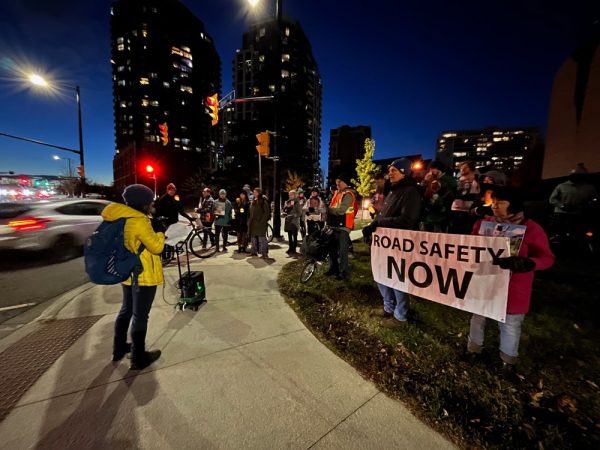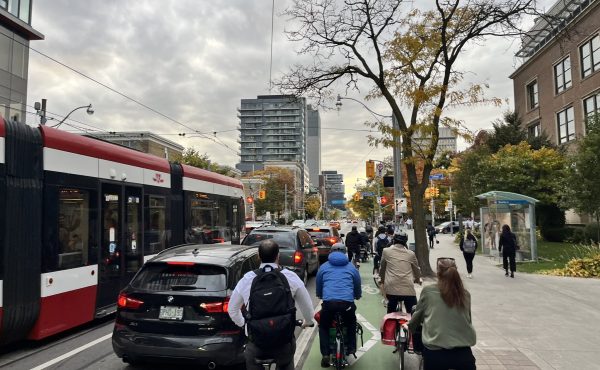By Albert Koehl and Roger Morier, road safety advocates and members of the We Belong on Bloor campaign of Community Bikeways.
There’s nothing new about NIMBY-ists circling their wagons to bleat about new public infrastructure that causes minor inconvenience to their way of life but delivers major benefits to many others. What’s new about a recent example in Etobicoke is the unified response by City Council to the NIMBY group.
At issue this time around is not a neighbourhood multiplex or a shade infringement but a Complete Streets project that will improve safety for pedestrians, cyclists, and (yes!) motorists.
In June this year, Councillors voted 21-1 in favour of the Bloor West Complete Street Extension (from Runnymede Road to Six Points, near Kipling Avenue). A 21-1 vote is not a wishy-washy, maybe-we-should, maybe-we-shouldn’t decision. It’s a resounding statement by our elected representatives, across the political spectrum, that urgent action is needed to meet the goals of our TransformTO Net Zero Strategy and Vision Zero Road Safety Plan.
A Complete Streets design isn’t a theoretical construct but a real-world difference-maker. During this year’s World Day of Remembrance for Road Traffic Victims on November 19, Friends and Families for Safe Streets guided participants along Bloor West in Etobicoke in a walk detailing the tragic casualties suffered by road users on the street over the past decade.
The Bloor West project will result in safer intersections, shorter pedestrian crossing distances, sidewalks protected by a bike lane — a welcome change for parents with young children — and lower motor vehicle speeds (by design). The project was informed by years of study, outreach to businesses to assess their needs, and widely publicized public consultations. Residents had ample opportunities to voice their views in person and on-line. Many did, and the project was adjusted and improved before installation.
The NIMBY-ists, however, didn’t go away after the Council vote, nor even wait for the project to be completed, before calling for a “re-evaluation.” They launched a petition, targeting — as has become custom — the bike lane, while conveniently ignoring the many related safety benefits. The opponents may not have paid attention to the recent mayoral election, won by bicycle-friendly Olivia Chow, and the dismal showing by candidates, including the former police chief, who touted anti-bike lane positions.
The opponents’ petition doesn’t actually include any data about the harm of the project (probably because there isn’t any). Instead, it vaguely claims impacts such as “decreased business footfall” even though studies have consistently shown that bike lanes are good for business. But for merchants who stubbornly believe that their success depends on motoring patrons, the Bloor West project area has a spectacular amount of GreenP parking: more than 1,200 spots.
The opposition did manage to recruit fellow Etobicoke resident and scandal-beleaguered Premier, Doug Ford, to their cause. At an unrelated press conference on October 31, Ford demanded the Bloor West bike lanes be ripped out, making the buffoonish claim that “we see one bicycle come through there every single year.” The comment prompted a rally that included hundreds of cyclists clogging the Bloor West bike lane between Runnymede Road and Tom Riley Park. Although the NIMBY-ists called on petition signatories to line the rally route in protest, fewer than half a dozen, including one man illegally placing signs in the road median, bothered to show up.
Despite aggressive (sometimes bordering on abusive) attacks on the local Councillor, Deputy Mayor Amber Morley, opponents are losing their NIMBY pursuit. When Morley presented their petition to City Council on November 8 she re-affirmed her support for the road safety project, highlighting the climate crisis, the need for accessibility and road safety, and the fast pace of growth in Etobicoke, concluding: “Going ahead with the Bloor Complete Street project is not only the responsible choice, it is an urgent choice.”
Yes, it’s hard to accept change, even when it’s for the safety of other residents, if that change threatens long-standing privilege. In the world of the NIMBY, the only person who doesn’t bear any blame for car emissions, car congestion, and car danger is the car driver.
For decades, our city has bowed to the notion that drivers of single-occupant cars should be able, at public expense, to drive anywhere at any time at virtually any speed. Then, when roads fill up, there should magically be new or wider roads. That model does not serve our neighbourhoods, our city, or our climate.
Complete Streets is a smart, proven approach to road safety that also addresses the worsening climate crisis. Thankfully, the wisdom of Toronto City Council has prevailed, tuning out the noise, embracing a Complete Streets approach, and moving forward with steadfast resolve to make Bloor West a safe street … for everyone.
Photo: Jun Nogami





3 comments
The priority is still the single-occupant automobile. Higher than pedestrians. Higher than public transit.
That line of thinking needs to change to move the single-occupant automobile downward.
While Bloor W. as one goes in to Etobicoke was very much a nasty carterial and needed to become safer, I’m less convinced it was so wise to push it out so far so fast, especially as there are a few situations in the old core that have more cyclists and danger, like Queen St. W. or Dupont/Ossington, as merely two examples of cycling dangers. And it’s absolutely appalling to me that the Queensway bike lane wasn’t made continuous in/from Parkdale in that most recent reconstruction as Parkdale deserves to have safe access to High Park, and those who are cycling in to core from Etobicoke deserve to have that Queensway bike lane/safety brought fully in to Roncesvalles. A smarter thing – politically and likely from a network too – would have been to gotten the Bloor lanes to Jane St. first, then pause, then perhaps to Royal York, as that hills of the Humber Valley are a bit discouraging for many, though the ebikes and safety may improve numbers. While most of the vehicles clogging up Bloor now appear to be largely single-occupant, and could the drivers use the subway?, with the limited options for all of us to cross the Humber, more thoughtfulness – which could have included a Jarvis-style reversible middle lane as retro and less-OK as that is – might have been wiser.
There could be An Act to Improve Cycling in Toronto from our auto-cratic Premier who is also very ‘carservative’, and the federal Liberals seem unable to defend democracy in Toronto/Canada as it’s too costly.
Queen St. W. does have the option of RIchmond and Adelaide, but these facilities fade out starting at Shaw, and getting in/out from Parkdale is treacherous/bad. My first comment was not so clear on that detail of need, known for decades, though the City doesn’t count the harms from streetcar tracks in their crash stats. There have been two bike deaths near the Dufferin underpass.